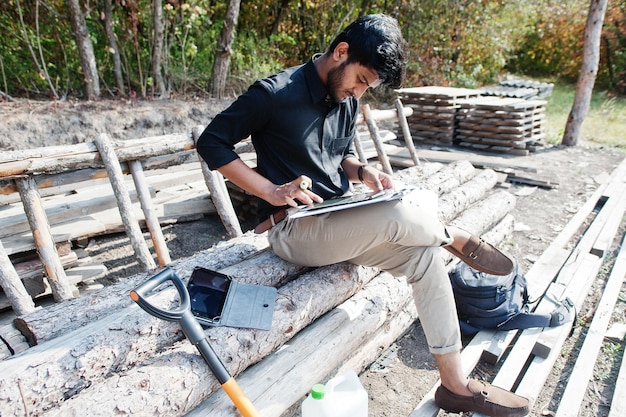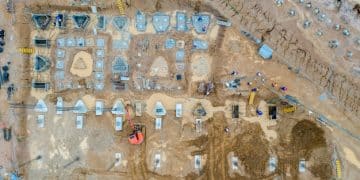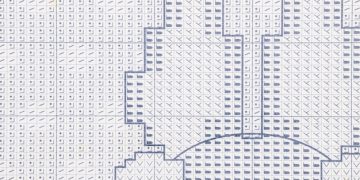US Construction Site Erosion Control: Best Practices for Compliance in 2025

Anúncios
Effective US construction site erosion control involves implementing best management practices and adhering to evolving regulatory compliance frameworks to protect environmental integrity and avoid penalties.
As the construction landscape evolves, mastering US construction site erosion control is not merely a regulatory obligation, but a cornerstone of sustainable development. This guide navigates the intricate world of erosion and sediment control (ESC) on construction sites, offering a deep dive into best practices and ensuring compliance by 2025.
understanding the erosion challenge on construction sites
Erosion on construction sites presents a significant environmental and economic challenge. The disturbance of natural landscapes during building new projects exposes soil to the elements, making it highly susceptible to displacement by wind and water. This process can lead to a cascade of negative impacts, from diminishing soil fertility and altering local hydrology to silting up waterways and harming aquatic ecosystems. Understanding the fundamental forces at play – rainfall intensity, soil type, slope steepness, and ground cover – is crucial for developing effective mitigation strategies.
soil erosion dynamics
Soil erosion is a natural process, but construction activities can dramatically accelerate its rate. Precipitation, particularly heavy rainfall, detaches soil particles, transporting them downhill or into drainage systems. Wind also plays a role, especially in arid regions or during dry periods, lifting fine particles into the atmosphere. The impact these forces have varies significantly with the physical characteristics of the soil and the existing topography. For instance, fine clay soils are more prone to wind erosion, while sandy soils are particularly susceptible to water erosion.
- Rainfall Impact: High intensity rainfall directly dislodges soil particles.
- Runoff Velocity: Faster water flow increases transport capacity of detached soil.
- Slope Gradient: Steeper slopes lead to higher runoff velocities and erosive power.
- Soil Type: Granular soils are more easily eroded than cohesive clays.
environmental and economic consequences
The consequences of uncontrolled erosion extend far beyond the immediate construction site. Sediment-laden runoff can degrade water quality in nearby streams, rivers, and lakes, impacting aquatic life and increasing treatment costs for drinking water. Sedimentation reduces reservoir capacities, clogs storm drains, and can even exacerbate flooding. Economically, off-site sediment deposition can incur significant cleanup costs, fines for non-compliance, and delays in project timelines. Investing in robust erosion control measures upfront is invariably more cost-effective than remediating damage later, underscoring the preventative nature of best practices.
In summation, recognizing the multifaceted nature of erosion is the first step toward effective mitigation. It’s about more than just moving dirt; it’s about managing an ecological and economic threat efficiently.
regulatory landscape: navigating EPA and state requirements for 2025
Navigating the regulatory landscape for erosion control in the US is complex, primarily governed by the Environmental Protection Agency (EPA) through the Clean Water Act. The National Pollutant Discharge Elimination System (NPDES) permit program mandates that construction sites disturbing one acre or more of land obtain a Stormwater Pollution Prevention Plan (SWPPP) and implement its measures. By 2025, these regulations are expected to maintain their stringent nature, with an increased focus on enforcement and the integration of newer, more data-driven compliance tools. State and local jurisdictions often impose additional, more specific requirements, making localized knowledge crucial for comprehensive compliance.
understanding the Clean Water Act and NPDES
The Clean Water Act is the cornerstone of US water quality regulation, aiming to restore and maintain the chemical, physical, and biological integrity of the nation’s waters. Under Section 402 of this Act, the NPDES program controls discharges into U.S. waters. For construction, this means obtaining a Construction General Permit (CGP), which outlines the specific conditions and requirements for managing stormwater runoff. These permits typically require the development and implementation of a SWPPP, regular inspections, and record-keeping.
- CGP Requirements: Covers sites disturbing one acre or more.
- SWPPP Mandate: Detailed plan for preventing stormwater pollution.
- Inspection Frequency: Typically weekly or after significant rainfall events.
- Reporting Protocols: Documentation of inspections, maintenance, and incidents.
state and local variations in compliance
While the EPA sets federal standards, states are largely responsible for implementing and enforcing their own NPDES programs, often referred to as State Pollutant Discharge Elimination System (SPDES) permits. These state-level permits can introduce additional requirements, such as specific design standards for erosion control measures, different inspection frequencies, or more stringent training mandates. Local municipalities may also add their own overlays, focusing on issues unique to their geography, such as protection of specific local waterways or stricter sediment discharge limits. It is imperative for project managers to be intimately familiar with all layers of applicable regulations to ensure full compliance and avoid costly penalties.
In summary, successful navigation of the regulatory environment necessitates a thorough understanding of both federal mandates and the nuanced requirements at state and local levels. Proactive engagement with these regulations ensures a project’s legality and environmental responsibility.
SWPPP development and implementation: your roadmap to compliance
A well-crafted and diligently implemented Stormwater Pollution Prevention Plan (SWPPP) is the central pillar of effective erosion and sediment control on any US construction site. This living document outlines the strategies, measures, and procedures a site will employ to prevent stormwater runoff from carrying pollutants, particularly sediment, into receiving waters. Its development requires a comprehensive understanding of site conditions, proposed construction activities, and applicable regulatory requirements. More than just a paper exercise, a SWPPP acts as a concise roadmap, guiding crew members and informing decision-making in real-time, thereby ensuring consistent compliance and environmental protection.
key components of an effective SWPPP
An effective SWPPP starts with a detailed site assessment, identifying potential pollutant sources, drainage patterns, and sensitive areas. It then specifies the Best Management Practices (BMPs) to be installed, maintained, and removed throughout the construction lifecycle. Crucially, the plan must include provisions for regular inspections, maintenance schedules for all BMPs, and clear instructions for corrective actions when deficiencies are identified. Training schedules for personnel involved in SWPPP implementation are also vital, ensuring that everyone on site understands their role in stormwater management. An active plan is one that is continually reviewed and updated as site conditions or construction phases change, ensuring its ongoing relevance and effectiveness.
- Site Description: Comprehensive overview of the project site.
- BMP Selection: Detailed list of erosion and sediment control measures.
- Inspection Procedures: Schedule and protocols for site monitoring.
- Maintenance Requirements: How BMPs will be kept in working order.
- Spill Prevention: Procedures for handling hazardous materials.

dynamic SWPPP management and updates
The SWPPP is not a static document submitted once and forgotten. It requires dynamic management, adapting to the evolving conditions of the construction site. As new phases of construction begin, areas are stabilized, or weather patterns shift, the SWPPP must be reviewed and updated to reflect these changes. This iterative process ensures that the chosen BMPs remain appropriate and effective for the current site conditions. Prompt and accurate record-keeping of all inspections, maintenance activities, rainfall events, and SWPPP modifications is paramount. Such rigorous documentation not only demonstrates compliance but also provides valuable data for continuous improvement in erosion control practices.
In essence, a well-managed SWPPP is a dynamic tool that empowers construction teams to proactively manage stormwater, reducing environmental impact and fostering a culture of compliance.
best management practices (BMPs) for erosion and sediment control
Effective Best Management Practices (BMPs) are the practical applications of erosion and sediment control theory on US construction sites. These measures are designed to prevent soil from eroding, to capture sediment before it leaves the site, or to manage stormwater runoff in a way that minimizes its erosive potential. The selection and implementation of BMPs must be tailored to specific site conditions, including topography, soil type, climate, and the duration of construction activities. A combination of structural and non-structural BMPs typically offers the most robust protection, ensuring comprehensive site coverage and adaptability to varying conditions, as required by updated regulations by 2025.
structural BMPs: physical barriers and control systems
Structural BMPs involve the installation of physical barriers or engineered systems to control flow, filter runoff, or stabilize soil. Silt fences are widely used for filtering sediment from sheet flow and slowing runoff, while straw wattles or fiber rolls can be employed on slopes to reduce erosion and trap sediment. Sediment basins and traps are designed to collect and detain larger volumes of sediment-laden water, allowing particles to settle out before discharge. Comprehensive and innovative structural BMPs also include check dams in swales, rock filters for dewatering, and temporary or permanent diversions to redirect clean runoff away from disturbed areas. The effectiveness of these measures heavily relies on correct installation and consistent maintenance throughout the project lifecycle.
- Perimeter Controls: Silt fences, super silt fences, and compost socks to trap sediment.
- Runoff Conveyance: Lined ditches, flumes, and temporary diversions.
- Sediment Traps/Basins: For sites with concentrated flow or larger drainage areas.
- Check Dams: Reduce flow velocity in channels and promote sediment deposition.
non-structural BMPs: stabilization and pollution prevention
Non-structural BMPs focus on protecting and stabilizing exposed soil surfaces and preventing pollution at its source, often through vegetative establishment or careful site management practices. Temporary seeding and mulching quickly establish vegetation cover, providing immediate protection against wind and water erosion, particularly in areas left undisturbed for extended periods. Permanent vegetation, once construction is complete, offers long-term stabilization. Regular street sweeping prevents tracked-out sediment from entering storm drains. Other non-structural methods include minimizing disturbed areas, phasing construction to reduce exposure time, and proper management of construction materials and wastes to prevent contamination of stormwater runoff. These practices are essential for a holistic approach to erosion control.
In conclusion, strategically combining both structural and non-structural BMPs creates a resilient defense against erosion and sedimentation, ensuring environmental compliance and mitigating potential damages.
inspections, monitoring, and maintenance: ensuring ongoing compliance
The mere installation of Best Management Practices (BMPs) on a construction site is not sufficient for achieving and maintaining compliance; rigorous inspections, continuous monitoring, and timely maintenance are equally critical. These ongoing activities ensure that the selected erosion and sediment control measures remain effective throughout the project lifecycle, adapting to changing site conditions and weather events. A robust inspection and maintenance program acts as the frontline defense against off-site sediment discharge and potential regulatory violations, solidifying a site’s commitment to environmental stewardship and reducing the overall risk profile of the project. Regular, documented oversight is the hallmark of a compliant and responsible operation.
effective inspection protocols
Effective inspection protocols are systematic and well-documented. Inspections typically occur on a prescribed schedule, such as weekly, and always within 24 hours of a significant rainfall event (often defined as 0.5 inches or more in a 24-hour period). Inspectors, who should be trained and knowledgeable in SWPPP requirements and BMP functionality, meticulously examine all installed measures for signs of failure, damage, or dislodgement. They also identify new areas of erosion or sediment accumulation and verify that pollutant sources are properly managed. Photographic documentation, detailed notes on observations, and clear recommendations for corrective actions are essential components of a thorough inspection report. This data is critical for demonstrating due diligence to regulatory agencies and guiding subsequent maintenance activities.
- Scheduled Inspections: Performed routinely, regardless of weather.
- Rainfall-Triggered Inspections: Mandated after qualifying rain events.
- Comprehensive Checks: Evaluate all BMPs and potential erosion spots.
- Documentation: Detailed reports, photos, and corrective action plans.
timely maintenance and corrective actions
The insights gained from inspections are only valuable if they lead to prompt and effective maintenance and corrective actions. When a BMP is found to be deficient – a silt fence is torn, a sediment basin is full, or stabilized areas are eroding – repairs or improvements must be implemented within a defined timeframe, often 24 to 48 hours. This swift response mechanism prevents minor issues from escalating into major compliance violations or significant environmental damage. Maintenance goes beyond fixing failures; it also includes routine upkeep such as clearing sediment from behind silt fences, reshaping berms, or reapplying mulch. Proactive maintenance, based on anticipated site use and weather conditions, further enhances the longevity and effectiveness of erosion control measures.

In essence, continuous vigilance through inspections and rapid response through maintenance are non-negotiable elements for sustaining a compliant and environmentally sound construction operation.
innovative technologies and future trends in ESC
The field of erosion and sediment control (ESC) on US construction sites is continuously evolving, driven by stricter regulations, a greater understanding of environmental impacts, and advancements in materials science and digital technology. As we look towards 2025 and beyond, innovative technologies are poised to revolutionize how construction sites manage stormwater and mitigate erosion, offering more efficient, cost-effective, and environmentally superior solutions. These emerging trends reflect a shift towards more proactive, data-driven, and sustainable approaches, pushing the boundaries of traditional erosion control methods and improving overall site performance.
advanced materials and sustainable solutions
Beyond traditional silt fences and straw wattles, newer advanced materials are gaining traction for their enhanced performance and sustainability. Biodegradable erosion control blankets made from natural fibers like coir, jute, or straw offer superior soil stabilization and degrade naturally over time, reducing waste. Super absorbent polymers are being explored to increase soil water retention, thus reducing runoff. Geotextiles and geocells are used for reinforcing slopes and preventing rill and gully erosion, offering robust, long-lasting protection. Furthermore, sustainable landscaping practices, incorporating native vegetation and low-impact development (LID) techniques, are becoming integral to ESC, particularly in post-construction scenarios, by mimicking natural hydrologic processes.
- Biodegradable Blankets: Natural fiber mats for temporary and permanent stabilization.
- Geosynthetics: Geotextiles and geocells for slope reinforcement and drainage.
- Living Stream Banks: Bioengineering using plants for natural erosion control.
- Low-Impact Development (LID): Rain gardens, permeable pavements for post-construction.
digital tools and remote monitoring
The integration of digital tools and remote monitoring systems is set to transform ESC management. Drones equipped with high-resolution cameras can conduct rapid, comprehensive site inspections, identifying erosion hotspots and BMP deficiencies more efficiently than manual methods. IoT (Internet of Things) sensors can monitor rainfall intensity and soil moisture levels in real-time, triggering automated alerts when conditions for high erosion risk are present. Cloud-based platforms facilitate centralized SWPPP management, allowing for instant updates, shared access for all stakeholders, and streamlined reporting to regulatory bodies. This data-driven approach promises to make ESC more proactive, responsive, and ultimately, more compliant and effective.
In conclusion, embracing these innovative technologies and sustainable practices is not just about meeting compliance; it’s about leading the way in responsible and efficient construction, setting new benchmarks for environmental stewardship in the sector.
training and stakeholder collaboration: building a culture of compliance
The most sophisticated erosion and sediment control (ESC) measures and robust SWPPPs are only as effective as the people implementing and maintaining them. Comprehensive training for all personnel involved in construction activities, from heavy equipment operators to site superintendents, is fundamental to establishing and sustaining a culture of compliance on US construction sites. Beyond internal training, fostering effective collaboration among all stakeholders—including contractors, regulators, consultants, and even local communities—can significantly enhance a project’s environmental performance. This holistic approach ensures that everyone understands their role and responsibilities, promoting collective ownership of environmental stewardship and shared commitment to regulatory adherence.
essential training components
Training for construction site personnel should encompass a range of topics, ensuring that individuals understand both the “why” and the “how” of erosion control. Key components include an overview of regulatory requirements (e.g., NPDES, SWPPP), the proper installation and maintenance of various BMPs, spill prevention and response procedures, and accurate record-keeping. The training should be practical, incorporating hands-on demonstrations where possible, and tailored to the specific tasks and responsibilities of different roles on site. Refresher training should be provided periodically, especially when new regulations are introduced or new personnel join the project, ensuring continuous competency and awareness of best practices.
- Regulatory Overview: Understanding applicable laws and permits.
- BMP Installation/Maintenance: Practical skills for effective deployment.
- Spill Response: Protocols for containing and reporting spills.
- Documentation: Importance of accurate record-keeping for compliance.
fostering stakeholder collaboration
Collaboration among stakeholders enhances problem-solving, improves communication, and builds trust. Early engagement with regulatory agencies can clarify expectations and identify potential challenges before they become costly issues. Working closely with environmental consultants brings specialized expertise to SWPPP development and BMP selection. Engaging with local communities, where appropriate, can address concerns and build goodwill, especially for large-scale projects. Within the project team, fostering an open communication environment where concerns about erosion control can be raised and addressed promptly is vital. When all parties feel invested in the project’s environmental success, compliance becomes a shared goal rather than a burdensome obligation.
Ultimately, a well-trained workforce operating within a collaborative framework transforms compliance from a regulatory hurdle into an integral part of high-quality, responsible construction practices.
| Key Aspect | Brief Description |
|---|---|
| 📊 Regulatory Adherence | Understanding and meeting EPA, state, and local erosion control mandates is non-negotiable. |
| 📝 SWPPP Excellence | A dynamic and comprehensive Stormwater Pollution Prevention Plan is the project’s compliance lifeline. |
| 🛠️ Proactive BMP Usage | Implement a mix of structural and non-structural BMPs tailored to site conditions and regularly maintain them. |
| 💡 Future-Proofing | Embrace innovative technologies and sustainable practices to enhance efficiency and effectiveness. |
frequently asked questions about construction site erosion control
A Stormwater Pollution Prevention Plan (SWPPP) is a site-specific document detailing how a construction project will prevent stormwater from carrying pollutants, especially sediment, off-site. It’s essential because it serves as the primary compliance document for federal Clean Water Act regulations (NPDES permits) and state/local requirements, outlining specific erosion and sediment control measures and maintenance protocols to safeguard water quality.
Most Construction General Permits (CGPs) require inspections of Best Management Practices (BMPs) at least once every seven calendar days. Additionally, inspections are typically mandated within 24 hours of any significant rainfall event, often defined as 0.5 inches or more within a 24-hour period. This dual-frequency approach ensures continuous monitoring and prompt identification of any deficiencies requiring maintenance.
Non-compliance with erosion control regulations can lead to significant consequences, including substantial monetary fines from federal, state, and local agencies. Projects may face stop-work orders, legal injunctions, and public scrutiny. Beyond penalties, uncontrolled erosion results in environmental degradation, increased cleanup costs, potential damage to adjacent properties, and delays in project schedules, all of which negatively impact a company’s reputation and profitability.
By 2025, technologies like drone-based inspections for rapid site assessment, IoT sensors for real-time rainfall and soil moisture monitoring, and advanced biodegradable erosion control materials are becoming more prevalent. Digital platforms for SWPPP management and reporting are also improving efficiency, allowing for data-driven decisions and more proactive stormwater management on construction sites.
Soil type significantly influences erosion control strategies. Fine-grained soils like clays and silts are highly susceptible to wind erosion and easily suspended in water, requiring more stringent sediment controls. Coarse-grained soils like sands are less prone to wind erosion but are more susceptible to water erosion due to rapid infiltration and particle detachment. Strategically, this dictates the selection of specific BMPs, such as the type of sediment barriers or the need for extensive soil stabilization.
conclusion: building a sustainable future
Mastering construction site erosion control in the US by 2025 demands more than mere compliance; it requires a proactive, integrated approach that combines robust planning, strategic implementation of Best Management Practices, continuous monitoring, and a commitment to innovation. As regulatory frameworks continue to evolve and environmental consciousness grows, the ability to effectively manage stormwater runoff and prevent sediment discharge will define the success and sustainability of construction projects. By embedding these principles into every phase of development and fostering a culture of environmental stewardship across all stakeholders, the industry can not only meet its obligations but also contribute positively to ecological preservation and build a more resilient future.





